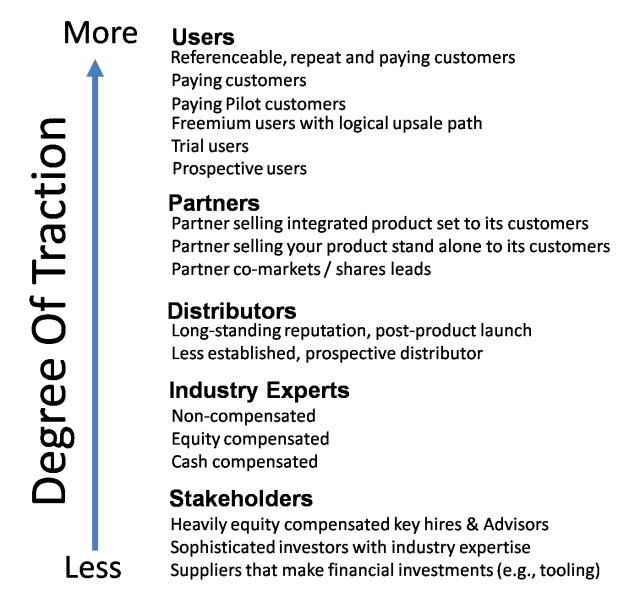 Nearly every entrepreneur has heard the refrain, "Get back to me when you have some traction,” while seeking funding. From an unsophisticated investor, this response might be a non-confrontational way of saying "No." However, when uttered by most Venture Capitalists (VCs) it conveys a desire to obtain validation of your venture's value proposition from dispassionate, objective third parties. In this context, your "value proposition" is defined as the utility you claim users will derive from your solution.
Nearly every entrepreneur has heard the refrain, "Get back to me when you have some traction,” while seeking funding. From an unsophisticated investor, this response might be a non-confrontational way of saying "No." However, when uttered by most Venture Capitalists (VCs) it conveys a desire to obtain validation of your venture's value proposition from dispassionate, objective third parties. In this context, your "value proposition" is defined as the utility you claim users will derive from your solution.
When you hear the word "traction" think "objective validation." Once people who do not know you and have no vested interest in your company's success begin expending their time, money and resources to leverage your value proposition, you are gaining traction.
If you haven't already subscribed yet,
subscribe now for free weekly Infochachkie articles!
Triangle Of Evidence
Evidence of validation manifests itself in many forms and is derived from a variety of market forces. Five broad sources of independent, third-party validation are: Customers, Partners, Distributors, Industry Experts and other Stakeholders. Each of these constituents is represented below in the Triangle Of Evidence that you must build in order to demonstrate that your venture has achieved meaningful traction.
The Inequity Of Validation
Not all validation is created equal. For instance, validation that directly supports your company's underlying value proposition is more valuable than corroboration that indirectly suggests customers might ultimately adopt your solution. As shown below, the most impactful form of traction is when your venture repeatedly convinces rational, third-party customers to happily part with their hard-earned cash, at a market price, in exchange for your solution.
However, not all ventures are mature enough to generate paying customers. Fortunately, for such startups, there are a number of precursors to paid customers, such as: trial users, freemium customers and qualified prospects.
In some industries, lengthy pilot tests are required before an enterprise customer will sign a definitive purchase order. In such cases, always extract meaningful compensation from these pilot customers to offset your costs and to increase the likelihood that the pilot user will convert to a paying customer. Free pilots typically have a lower conversion rate, as the lack of a financial decision at the outset of the relationship reduces the thoughtfulness in which the prospect enters the pilot.
The following manifestations of traction are not intended to represent an exhaustive list. Rather, they serve to illustrate the relative value of common sources of validation, from the most to least impactful.
The Three P's: Positive, Polite And Persistent
So what do you do once your venture has traction? As noted in 6 Steps To Raising Venture Capital, as you accomplish your previously communicated milestones, send your target VCs a brief email update (think eye-candy graphics and charts, not dense text). These updates will demonstrate your ability to execute upon your stated objectives and will help you stay top-of-mind in the VC's chaotic world.
The cadence of such communications should be as consistent as is practical, with a tone that is always be positive and polite. Although I have always been extremely persistent in my professional follow-up, no one has (yet) issued a restraining order asking me to back off. In a like manner, proudly profess your traction to your target VCs until they either write you a check or ask you to look elsewhere.
Follow my startup-oriented Twitter feed here: @johngreathouse. I don't tweet about unicorns, NBA Memes or photos of food I am about to devour - just startup stuff.
Note: The Triangle Of Evidence was stolen from Frank Foster, a friend, talented investor and Managing Director of DFJ Frontier, a successful, early-stage VC fund.
Photo Credit: ralphbijker via Flickr





